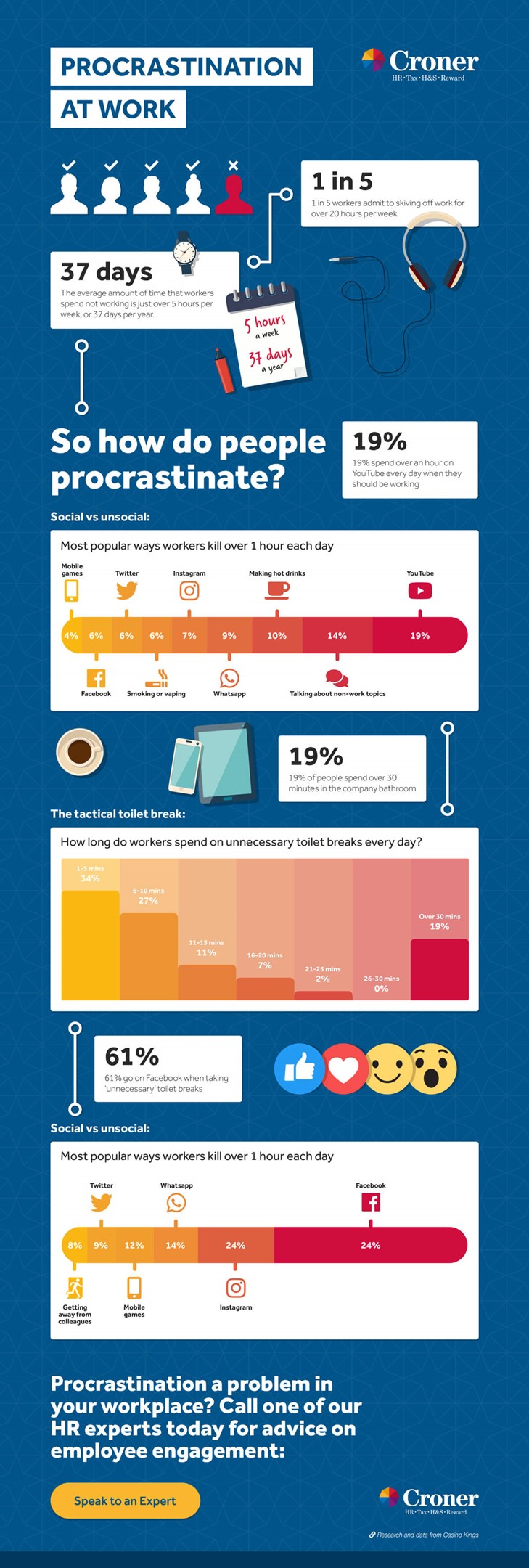No-one spends every second of every working day on the job. Sometimes you have to make a drink, take a bathroom break, and catch up with colleagues. Taking regular breaks is good for your health— physical and mental.
However, employees can take advantage. If you don’t believe that’s true, you might want to stop reading here.
How employees procrastinate at work
Add this infographic to your website by copying and pasting the following embed code:
How to combat procrastination
So how do you keep your workforce productive and engaged? It depends on the nature of work and type of employee, of course. But, there are a few tactics you can employ to most workplaces.
1. Encourage regular breaks
If employees already have intervals in their work day, they’re less likely to need more. This way, you have control over when breaks happen, and how long they go on for. Just make sure everyone is aware of what is a reasonable amount of time to be away from their workspace.
2. “Cheat” deadlines
If you have time limits, people are going to leave important work until the last minute. That’s just how some employees function.
How do you stop this? Set fake deadlines.
As long as the cutting off point isn’t ridiculous, employees’ aren’t going to realise. You get your work done before the deadline, and the employee gets to leave the work until the last minute—everybody wins!
3. Offer flexible working and rewards
Some people work better at different times in the day. Flexible working means employees can show up and work when they’re at their most productive. But we get it—for some employers, flexible working just isn’t possible. So instead, why not offer an early finish when a big job gets finished? Or, an extended lunch break.
If flexibility really is a no-go, financial rewards work just as well. Simple things such as a free lunch, a bonus, or a cash incentive for the best performer. People are less likely to procrastinate when money is up for grabs.
4. Hold employees accountable
If incentives don’t work, accountability will. If there’s a group project with multiple people working on it, ensure each person knows they’re wholly responsible for their contribution. That way, if a deadline is missed, or the work isn’t sufficient, it’s their problem.
This is a tough approach, but a fair one. Those who are pulling their weight won’t be punished, and those who aren’t get singled out. They’re unlikely to make the mistake a second time.
5. Communicate
Ultimately, nothing beats addressing the issue with the employee directly. Don’t be afraid to have an informal meeting with the procrastinator to discuss the matter. Don’t be confrontational or accusatory. The discussion should be about finding out why the distractions are happening and how you can help reduce them. The outcome of this chat might surprise you.
If the employee continues to procrastinate after the meeting, you can consider other options. This includes beginning a disciplinary process.
Expert support
If you have questions about employee performance, procrastination, or any other HR issue, speak to a Croner expert today on 01455 858 132.
Related resources
Categories
- Business Advice
- Culture & Performance
- Disciplinary & Grievances
- Dismissals & Conduct
- Employee Conduct
- Employment Contracts and Documentation
- Employment Law
- Employment Rights Bill
- End of Contract
- Equality & Discrimination
- Health & Safety
- Hiring and Managing
- Leave & Absence
- Managing Health & Safety
- Moving
- Occupational Health
- Pay & Benefits
- Recruitment
- Risk & Welfare




